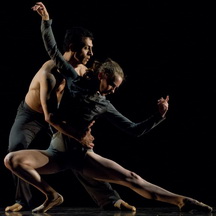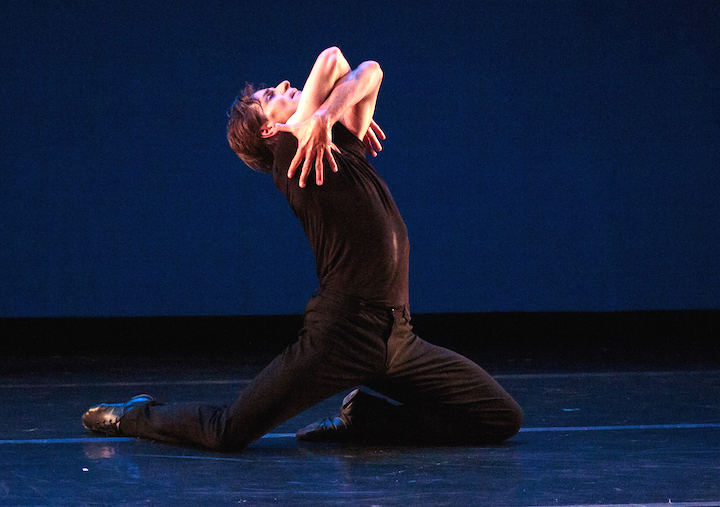The dancer leans back, one leg extended, arms held close to the body, creating a long diagonal line from toe to head. He steps forward, leaning in the opposite direction, creating a second long diagonal. He then pulls both feet together, and stands upright, his arms moving upward until they are overhead and his hands are turned outward in a pose softly reminiscent of flamenco. Then he sinks down into demi plié. The movement repeats.
José Limón’s “Chaconne” – a solo piece choreographed in 1942 – was performed as part of SFDanceworks’ second season at the ODC Theater. Limon never shied away from beauty, and Pascal Molat performed this piece beautifully, with disciplined athleticism and a deep emotional connection that revealed, breathtakingly, the dancer’s soulfulness. It was an enchantment to see Molat, who retired from San Francisco Ballet last year, so up close and personal. And to have Bach’s music performed live with the violin soloist, René Mandel, onstage with the dancer.
“Chaconne” was only one of six pieces performed by the nine wonderful dancers who made up the cast of SFDanceworks repertory company this year. SFDanceworks was founded in 2014 by SF Ballet soloist, James Sofranko. Its mission is to present choreographic work by emerging choreographers alongside classics of dance.
The chamber-work atmosphere of the program, with short pieces performed by few dancers – the longest most complex piece had seven dancers – in this small theater, gave the entire performance an intimate feel. Dance’s distant and detached quality was moderated. And though none of the audience was likely to run onto the stage and join in the complex and vividly energetic dancing, the performance did feel special – as if the dancers were as aware of the audience as it was of them. We were no longer peering through a proscenium at a world that exists in another time and place – unreachable and tinged with myth.
Rarely do we get to enjoy such closeness with such skilled dancers. What a privilege!
The program opened with Alejandro Cerrudo’s “Never Was,” danced by Danielle Rowe and Brett Conway. Begun in low lighting with large movements to a percussive piece by Purcell, the duet is both athletic and balletic before slipping into a more lyrical movement set to Handel’s “Ombra mai fu”, the poignant and exquisite opening aria from Serses. Like the music, the choreography had a formal quality, amply using symmetrical and synchronized movement.
Rowe also choreographed the other duet in the program, “For Pixie”, set to Nina Simone’s earthy voice and lush piano stylings. The piece opened with Laura O’Malley enacting the insistent rhythm of a clock’s tick. She was joined by Brett Conway, and the two moved with compelling precision in Rowe’s charged choreography.
James Graham’s “Two Dimes and a Nickel” was a more theatrical and self-conscious piece, danced by Dana Genshaft, Garrett Anderson and Kendall Teague. Graham has worked with Joe Goode, and the spoken word parts of the performance were reminiscent of Goode – “This boy he stands out from the crowd … I’m comfortable in the space I’m in” – in which the speaker reveals his struggle with alienation and sexuality. The choreography was more gymnastic, repeating patterns obsessively.
Presenting work from international choreographers is also part of Sofranko’s vision and this year he presented a short work by British choreographer Christopher Bruce. Well known in the UK, Bruce has worked in a number of choreographic styles including ballet and musical theater. He was the artistic director of the Rambert Dance Company for eight years, retiring in 2002, but had been associated with the company for 40 years, dancing as its male lead until moving into choreography. “Shadows” (2014) was set to one of Arvo Pärt’s many versions of Fratres. The work opens with four dancers sitting at a table upstage. This companionable setting is immediately destroyed when Steffi Cheong breaks into an intensely dynamic solo, one that is echoed in various ways by the other three dancers through the course of the piece. At the end the four dancers put on coats and hats and line up shoulder to shoulder, carrying luggage. The image and the dance suggest upheaval, a holocaust of emotion and an eternal leave-taking.
The final work of the evening was “Soir Bleu” (2015) choreographed by Penny Saunders. With seven dancers, the composition was inspired, according to the program notes, on the enigmatic painting by Edward Hopper, and explored “transitory moments.” The narrative is less clear than that of the other works in the program, but like all the pieces it was absorbing, straddling a dance vocabulary that was based on ballet but partook of a range of modern and contemporary dance. It was, as everything in this program, vibrantly danced.
Bravo to SFDanceworks!
– Jaime Robles
Photo: Pascal Molat dances José Limón’s “Chaconne” in the second season of SFDanceworks. Photo by Alexander Reneff-Olson.

